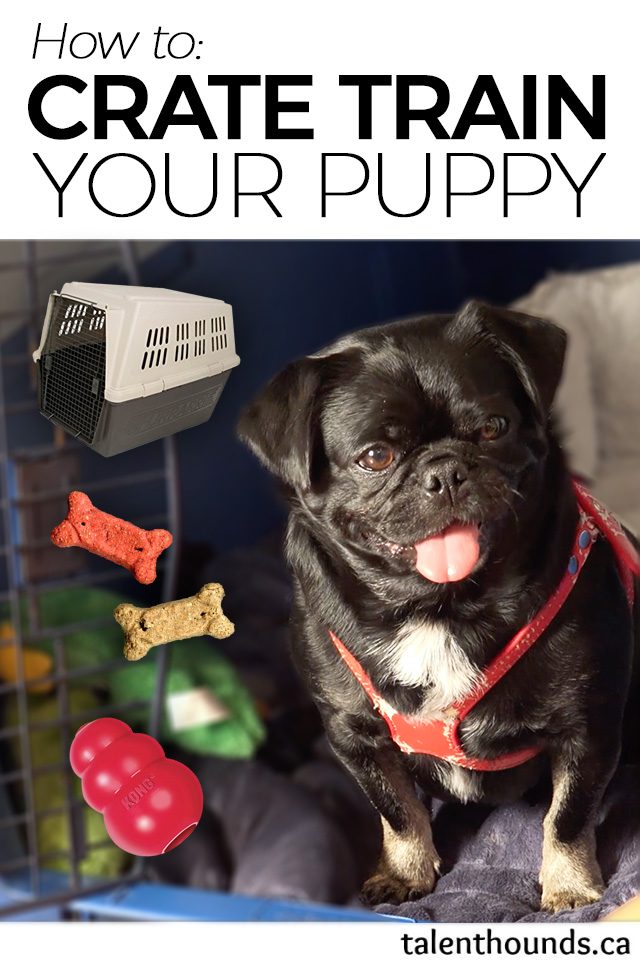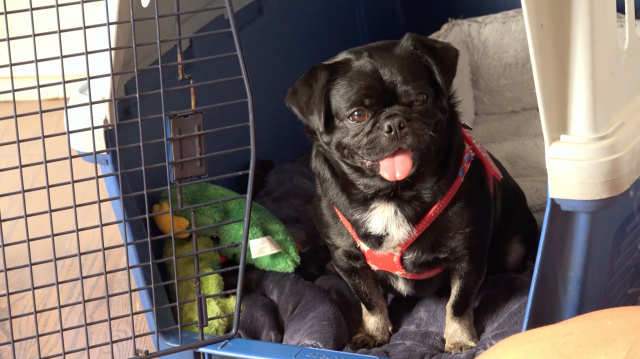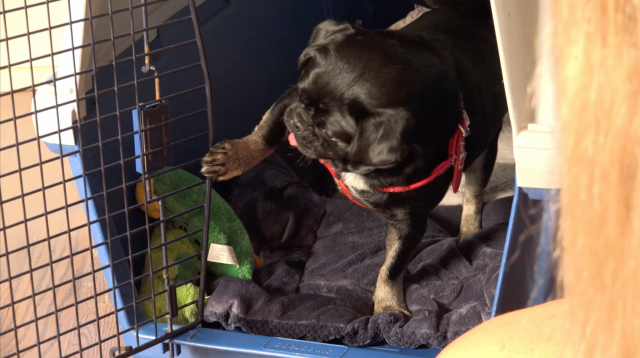
Before I started researching for Talent Hounds, I thought crates looked like cages and I was dubious about the benefits. I only used them to travel with my big dogs. However today, I believe Crate Training is very important when getting a new puppy or even an older rescue dog.
With the right crate, training and care, a dog’s crate can become one of their favorite places to sleep or take a break. It is a safe area where they can relax and not get into trouble if you can not supervise them or if they feel anxious. It can also be helpful in toilet training as most dogs do not like to soil their sleeping area.
Of course you should never leave a puppy or dog too long in their crate during the day or even at night and make sure you take them potty, socialize and exercise them enough.
Find out how to crate train your new puppy by seeing what I did with Kilo the Pug.
I am not an expert trainer and Kilo is not an easy trainee but I figure, if we can do it, so can you.
I introduced Kilo to his crate from the first day we started fostering him and he LOVES his crate now. It was great for me as I did not know what he would get up to if I was not watching him. I knew he and the cat and the house were safe with him in his crate. Plus he could not go and pee and poop all over the house during the night (he was not properly house-trained).

Make Your Dog’s Crate Welcoming and Comfortable
Your dog’s crate should be a clean, safe and welcoming place. To do this, place a bed, a soft blanket and your dog’s favourite safe toys inside. Kilo has a small bed to curl up in on a bigger orthopedic mattress and blankie and some plush toys. Everything is washable.
Make sure that the crate is large enough for your dog to move comfortably in and grow into. It shouldn’t feel uncomfortable or be too confining. Kilo has a palace as he inherited my lab’s crate. He throughly enjoys the space.
If you would like a crate like Kilo’s, check out my Amazon Affiliate link here:
Petmate Sky Kennel Portable Dog Crate Travel Items Included 6 Sizes
Place your crate in a part of the home that you and your family use often, like your living room or in a quiet place where your puppy can sleep easily at night if you entertain or make noise or have lights on in the busier area. It should not be too hot or too cold.
Kilo’s crate started out off the living room but after a few weeks, when he had adapted well to the crate, he moved down to my office in the basement where it is darker and quieter. He takes himself down there at night when he wants to go to bed. We can still hear him easily if he calls.
Crate Train with Rewards
Start training by coaxing your dog to go into the crate. You can do this by tossing in their favorite treat or toy in. When they enter the crate, reward them. Gradually add a marker phrase when you reward them. I use “Night, night” and I have friends that say “kennel up”.
I sometimes give Kilo frozen stuffed Kongs so he is happy, occupied and relaxed for longer when he goes into his crate.
You can even feed your dog meals in the crate to create a positive atmosphere for your dog. This can be very effective if you have multiple dogs or puppies as no one steals or fights over food.
Our Routine at Night

At night, I wait until Kilo is tired and we have cuddled a lot (usually around 10pm). I take him potty, take off his harness (he sleeps nakey), then take him down with some treats and say “Night, Night”. He goes in to his crate very willingly and goes to sleep fast most nights.
Some nights he takes himself to bed if he is tired as he likes it so much. I then just go down and take off his harness and shut his crate door (although he can sort of shut it if he is hiding treasure like socks in there LOL – he definitely considers it his own private space and is a bit defensive of his things in it now).
I check he does not have a problem on the rare occasion he calls me after I shut the door. He may need a little more cuddling, especially if I have been out or travelling, or to go potty again, but usually he is fine until morning. He was already 2 when he came to us so he could usually last the night without a pee as long as he went out before bed.
I also use Kilo’s crate if we have strangers working on the house or installing things or if he gets worked up about something to cool off.
Training your dog to stay happily in their crate takes time, however, it can be fun. If you pay attention to your dog’s feelings, motivate and reward them, and have patience, your dog should begin to understand the purpose of his crate and enjoy it like Kilo.
Did You Crate Train Your Puppy? Any tips to share?
Happy training! For more videos be sure to subscribe to our YouTube Channel. Also, check out more training tips and tricks for your dog.

Really enjoyed the training tips.